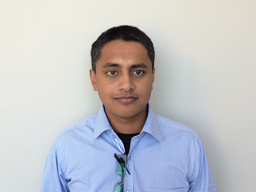Location
Off Campus : via Webex
Date & Time
June 25, 2020, 10:00 am – 12:00 pm
Description
ADVISOR: Dr. Zhibo Zhang
TITLE: Interactions of Radiation with Aerosols and Clouds in a Three-Dimensional Atmosphere: Implications for Aerosol and Cloud Remote Sensing
ABSTRACT: The global measurements of the properties of clouds, aerosols, and aerosol-cloud interactions are primarily based on satellite remote sensing. Thus, the retrieval artifacts associated with the remote sensing techniques have significant implications in our understanding of the properties of clouds, aerosols, and their influence on the weather and climate. For the sake of computational efficiency, the passive remote sensing techniques often assume the atmosphere as a collection of horizontally homogeneous, radiatively isolated columns. When the realistic atmosphere deviates from these assumptions, the retrieval technique is susceptible to the biases that are often referred to as “3D effects”. To study the 3D effects in the aerosol and cloud property retrievals, ideally, it is required to compare the retrieved-properties with the underlying physical properties. Such comparisons are problematic to achieve based on the observational data. In this work, we simulate both 3D and 1D radiative transfer in the large-eddy simulation cloud fields (LES-cloud fields) and artificially synthesize the “satellite data products” to perform a comprehensive study on the 3D radiative effects of cloud and aerosol property retrievals. This thesis is organized as follows: A brief introduction of two popular cloud remote sensing techniques, one based on spectral radiometric observations and the other on polarimetric observations of cloud reflectance, is provided in Chapter 1. The aerosol and cloud remote sensing simulator based on the LES model and radiative transfer models are described in Chapter 2. In Chapter 3, we present a study of the potential interactions between the seasonal above cloud smoke and the underlying stratocumulus cloud in the southeast Atlantic region based on space-borne lidar observations. In Chapter 4, we investigate the impacts of the 3-D radiative effects on the so-called bi-spectral method for remote sensing of cloud optical thickness and effective radius. In particular, we present a novel framework based on two-dimensional Taylor expansion that provides a more comprehensive understanding of the convoluted impacts of 3-D radiative effects on the simultaneous COT and CER retrievals. In Chapter 5, we present a study of the 3-D radiative effects on the CER and CEV retrievals based on the multi-angular polarimetric observations. Several important 3-D radiative effects, such as the parallax effect, and their impacts on the polarimetric retrievals are identified and the underlying physics illustrated. Finally, in Chapter 6, we explore a novel method to identify the 3-D radiative effect in the operational cloud remote sensing algorithms based on the combination of bi-spectral and polarimetric observations. The results from this study are expected to improve our understanding of the uncertainties caused by 3-D effects in our satellite remote sensing product and also useful for the planning of future satellite missions.
Defense will be held using Webex.
TITLE: Interactions of Radiation with Aerosols and Clouds in a Three-Dimensional Atmosphere: Implications for Aerosol and Cloud Remote Sensing
ABSTRACT: The global measurements of the properties of clouds, aerosols, and aerosol-cloud interactions are primarily based on satellite remote sensing. Thus, the retrieval artifacts associated with the remote sensing techniques have significant implications in our understanding of the properties of clouds, aerosols, and their influence on the weather and climate. For the sake of computational efficiency, the passive remote sensing techniques often assume the atmosphere as a collection of horizontally homogeneous, radiatively isolated columns. When the realistic atmosphere deviates from these assumptions, the retrieval technique is susceptible to the biases that are often referred to as “3D effects”. To study the 3D effects in the aerosol and cloud property retrievals, ideally, it is required to compare the retrieved-properties with the underlying physical properties. Such comparisons are problematic to achieve based on the observational data. In this work, we simulate both 3D and 1D radiative transfer in the large-eddy simulation cloud fields (LES-cloud fields) and artificially synthesize the “satellite data products” to perform a comprehensive study on the 3D radiative effects of cloud and aerosol property retrievals. This thesis is organized as follows: A brief introduction of two popular cloud remote sensing techniques, one based on spectral radiometric observations and the other on polarimetric observations of cloud reflectance, is provided in Chapter 1. The aerosol and cloud remote sensing simulator based on the LES model and radiative transfer models are described in Chapter 2. In Chapter 3, we present a study of the potential interactions between the seasonal above cloud smoke and the underlying stratocumulus cloud in the southeast Atlantic region based on space-borne lidar observations. In Chapter 4, we investigate the impacts of the 3-D radiative effects on the so-called bi-spectral method for remote sensing of cloud optical thickness and effective radius. In particular, we present a novel framework based on two-dimensional Taylor expansion that provides a more comprehensive understanding of the convoluted impacts of 3-D radiative effects on the simultaneous COT and CER retrievals. In Chapter 5, we present a study of the 3-D radiative effects on the CER and CEV retrievals based on the multi-angular polarimetric observations. Several important 3-D radiative effects, such as the parallax effect, and their impacts on the polarimetric retrievals are identified and the underlying physics illustrated. Finally, in Chapter 6, we explore a novel method to identify the 3-D radiative effect in the operational cloud remote sensing algorithms based on the combination of bi-spectral and polarimetric observations. The results from this study are expected to improve our understanding of the uncertainties caused by 3-D effects in our satellite remote sensing product and also useful for the planning of future satellite missions.
Defense will be held using Webex.
